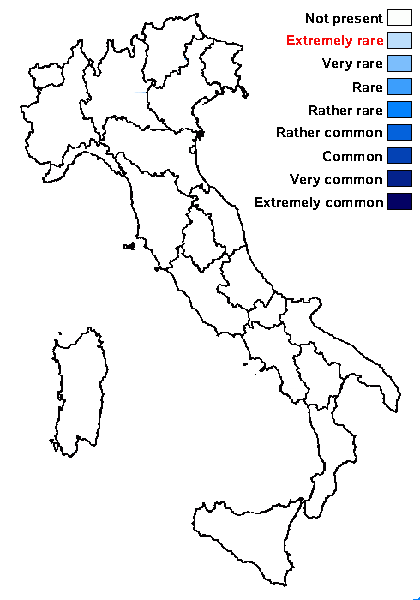Rinodina crespoae Giralt & H. Mayrhofer
Herzogia, 10: 30, 1994
Synonyms:
Distribution:
Description: Thallus crustose, thinly episubstratic, dark olive-brown to brown, rimose-areolate, without an evident prothallus. Apothecia lecanorine, 0.2-0.4 mm across, adnate, usually contiguous and covering most of the thallus, with a dark brown, persistently flat disc, and a thick, entire, persistent thalline margin whose thick cortex reacts I+ blue. Thalline exciple corticate, the cortex nearly indistinct laterally, expanding to 25-30 µm in lower part; epithecium reddish brown; hymenium colourless, 80-120 µm high, I+ blue; paraphyses 1.7-2.3 µm thick at mid-level, the apical cells up to 3 µm wide; hypothecium pale yellow, 20-50 µm high. Asci (8-)12-16-spored, clavate, the K/I+ blue tholus penetrated by a faintly amyloid apical cushion with parallel or diverging flanks, the wall K/I-, surrounded by a K/I+ blue outer layer, Lecanora-type. Ascospores 1-septate, not swollen around septum after pre-treatment with K, pigmented, ellipsoid, (10-)13-15(-16.5) x 6-7(-9) µm, with thin lumina and minutely warted walls, Milvina-type, the torus well-developed, with an ontogeny of type A (apical wall thickening after septum formation). Photobiont chlorococcoid. Spot tests: thallus and medulla K-, C-, KC-, P-, UV-. Chemistry: without lichen substances. Note: a rare, mainly Mediterranean species, known from Central Spain; it grows on small twigs, associated with pioneer nitrophilous lichens, To be looked for in Italy, especially in Sardinia.
Growth form: Crustose
Substrata: bark
Photobiont: green algae other than Trentepohlia
Reproductive strategy: mainly sexual
Pioneer species

Predictive model
Growth form: Crustose
Substrata: bark
Photobiont: green algae other than Trentepohlia
Reproductive strategy: mainly sexual
Pioneer species

Predictive model
 Index Fungorum
Index Fungorum
 GBIF
GBIF

